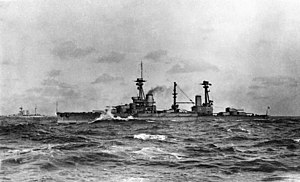HMS Agincourt (1913)

HMS Agincourt in 1915 with HMS Erin in the background
|
|
| History | |
|---|---|
|
|
|
| Name: | Rio de Janeiro |
| Namesake: | Rio de Janeiro |
| Builder: | Armstrong, Newcastle upon Tyne |
| Preceded by: | Minas Geraes class |
| Succeeded by: | Riachuelo |
| Cost: | $14,500,000 (estimated) |
| Yard number: | 792 |
| Laid down: | 14 September 1911 |
| Launched: | 22 January 1913 |
| Fate: | Sold December 1913 to the Ottoman Empire |
|
|
|
| Name: | Sultan Osman-ı Evvel |
| Namesake: | Sultan Osman I |
| Acquired: | December 1913 |
| Fate: | Seized in August 1914 by the United Kingdom |
|
|
|
| Name: | HMS Agincourt |
| Namesake: | The Battle of Agincourt of 1415 |
| Cost: | £2,900,000 (estimated) |
| Completed: | 20 August 1914 |
| Acquired: | 3 August 1914 |
| Commissioned: | 7 August 1914 |
| Decommissioned: | April 1921 |
| Nickname(s): | Gin Palace |
| Fate: | Sold 1922, scrapped 1924 |
| General characteristics (in British service) | |
| Type: | Dreadnought battleship |
| Displacement: |
|
| Length: | 671 ft 6 in (204.7 m) |
| Beam: | 89 ft (27.1 m) |
| Draught: | 29 ft 10 in (9.1 m) |
| Installed power: | 34,000 shp (25,000 kW) |
| Propulsion: |
|
| Speed: | 22 knots (41 km/h; 25 mph) |
| Range: | 7,000 nmi (13,000 km; 8,100 mi) at 10 knots (19 km/h; 12 mph) |
| Complement: | 1268 (1917) |
| Armament: |
|
| Armour: | |
HMS Agincourt was a dreadnought battleship built in the United Kingdom in the early 1910s. Originally part of Brazil's role in a South American naval arms race, she held the distinction of mounting more heavy guns (fourteen) and more turrets (seven) than any other dreadnought battleship, in keeping with the Brazilians' requirement for an especially impressive design.
Brazil ordered the ship in 1911 as Rio de Janeiro from the British company Armstrong Whitworth. However, the collapse of Brazil's rubber boom and a warming in relations with Argentina, the country's chief rival, led to the ship's sale while under construction to the Ottoman Empire. The Ottomans renamed her Sultan Osman I, after the empire's founder, and the ship was nearly complete when World War I broke out. British fears of a coming Ottoman–German alliance led to her seizure for use by the Royal Navy, together with another Ottoman dreadnought being constructed in Britain. This act was a significant contributor to the decision of the Ottoman government to join the Central Powers, as the payments for both ships were complete.
Renamed HMS Agincourt by the Royal Navy, she joined the Grand Fleet in the North Sea. During the war, the ship spent the bulk of her time on patrols and exercises, although she did participate in the Battle of Jutland in 1916. Agincourt was put into reserve in 1919 and sold for scrap in 1922 to meet the terms of the Washington Naval Treaty.
In the unstable period during and following the 1889 revolution in Brazil, which deposed Emperor Dom Pedro II, and the 1893–94 navy revolt, the Brazilian Navy found itself unable to care for its own ships, let alone acquire new vessels. Meanwhile, Chile had agreed to a naval-limiting pact in 1902 with Brazil's principal rival, Argentina, as part of solving a larger boundary dispute, but they both retained the vessels built in the interim, many of which were significantly more modern and powerful than Brazil's ships. The Brazilian Navy was left behind its Argentine and Chilean counterparts in quantity as well—by the turn of the 20th century, Chile's total naval tonnage was 36,896 long tons (37,488 t), Argentina's 34,425 long tons (34,977 t), and Brazil's 27,661 long tons (28,105 t)—even though Brazil had nearly three times the population of Argentina and almost five times that of Chile.
...
Wikipedia
